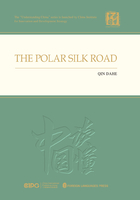
Preface
The Arctic region is attracting global attention as a common home for humanity. However, unlike the “pure” Arctic in people’s imagination, amid global warming, the Arctic’s cryosphere, ocean, atmosphere, and biology have been damaged to varying degrees, and its ecosystem is under serious threat. On the other hand, climate warming also makes Arctic resource development and summer navigation possible, giving greater prominence to the region’s geostrategic value. The Arctic states, world powers, and international organizations have shown a keen interest in the region, thrusting the Arctic into the global spotlight.
The concept of the Polar Silk Road (PSR) was first proposed by Russia. It was put forward by Russian Defense Minister Sergei Shoigu at the 2nd International Forum on “The Arctic: Territory of Dialogue” in 2011. Subsequently, the concept received positive responses from China and other relevant countries, and was included in the Chinese government’s “China’s Arctic Policy” whitepaper. With its concept and connotation further deepened in practice by China and Russia, the PSR not only refers to the shipping routes across the Arctic Circle which connect the three major economic centers of North America, East Asia, and Western Europe; more significantly, it constitutes a natural extension of the Belt and Road Initiative (BRI) to the Arctic.
As a supplement to the BRI, the PSR is conducive to building a“community with a shared future for mankind.” The PSR focuses on the development of the Arctic shipping routes, and to this end, China has made strong efforts to explore the PSR shipping routes. Although the regions along the PSR are sparsely populated, they are home to rich and unique traditional cultures and customs. In the process of building the PSR, with the wellbeing of the indigenous peoples in mind, China has endeavored to study and protect traditional cultures. Furthermore, as an extension of the BRI, the PSR’s development requires the participation and cooperation of countries along the routes, and many countries are indeed cooperating with China at various levels. As a value concept, the PSR dovetails nicely with the development concept of a “community with a shared future for mankind.” Moreover, it carries forward and advances the purposes of the Charter of the United Nations.
As a near-Arctic state and an observer of the Arctic Council, China has the responsibility and obligation to participate in Arctic governance, and is expected to play its role as a responsible power. In recent years, China has made significant contributions to the rational development of the Arctic region through scientific research, ecological restoration, and environmental protection. China is also deeply aware that the Arctic region is an invaluable asset for all humanity and needs to be better protected with the concerted action of all countries. In the face of environmental changes in the Arctic, China’s initiative to jointly build the PSR is an affirmation of the Chinese people’s commitment to serving all mankind.
This book aims to tell readers China’s concrete efforts towards turning its PSR vision into reality. Presenting stories with vivid details, it gives the world a better understanding of China’s contributions to the Arctic, as well as the philosophy of the PSR proposed by China and the vision of a “community with a shared future for mankind” embodied by the PSR.
Consisting of eight chapters, this book presents a comprehensive account of the PSR’s past, present and future. Chapter I introduces the PSR’s background, development, and evolution, expounding its status as an extension of the BRI. Chapter II elaborates on the PSR’s geographical environment from the natural and cultural perspectives, as well as China’s contribution to environmental protection in the regions along the PSR. Chapter III introduces scientific explorations and China’s scientific research activities in the regions along the PSR. Chapter IV analyzes the regional and global impacts of climate change in the Arctic, focusing on the impact of climate warming on the PSR. Chapter V explores the status and development prospects of the Northwest and Northeast Passages, as well as China’s scientific exploration of the Arctic shipping routes. Chapter VI gives an account of the development of the indigenous peoples and their cultural preservation, showing to the world the efforts made by China in cultural exchange and preservation. Chapter VII introduces the international cooperation in building the PSR, focusing on the cooperation between China and the countries in the regions along the PSR. Chapter VIII presents China’s solution for the PSR’s development, affirming that the PSR is an application of China’s new development concept in the Arctic, an extension of China’s BRI to the Arctic, and an implementation of China’s ideal of building a “community with a shared future for mankind” in the Arctic.
As part of the “Understanding China” series, this book is intended for general readers worldwide. With this book, people who are interested in China’s role in Arctic governance can gain new knowledge and clear their doubts, and this will facilitate cooperation. The book is written in a style typical of the “Understanding China” series, focusing on the combination of theory and facts, and impressing readers with real Chinese actions. In an in-depth and factual manner, it tells the story of China’s relationship with the Arctic, sharing China’s experience in Arctic governance and solution for the joint development of the PSR; it thus enables readers to gain new insights into the Arctic and China.
Li Chunlan, Mou Yatu, and Wang Yiyao from the Center for Geographical and Strategic Studies at East China Normal University assisted in the collection and collation of materials for this book. Ren Jiawen, Ding Yongjian, Xiao Cunde, Liu Chengliang, Hu Zhiding, and Ma Yahua took part in the discussion of the manuscript. Li Yaoyao, Liao Xuejie, Tan Xueling, Li Yijie, and Xu Jiayi participated in the preliminary preparation of the book. I owe them an enormous debt of gratitude for their hard work. I am also deeply grateful to my colleagues and friends for their support and help with the publication of this book.
Qin Dahe
Shanghai, October 16, 2021